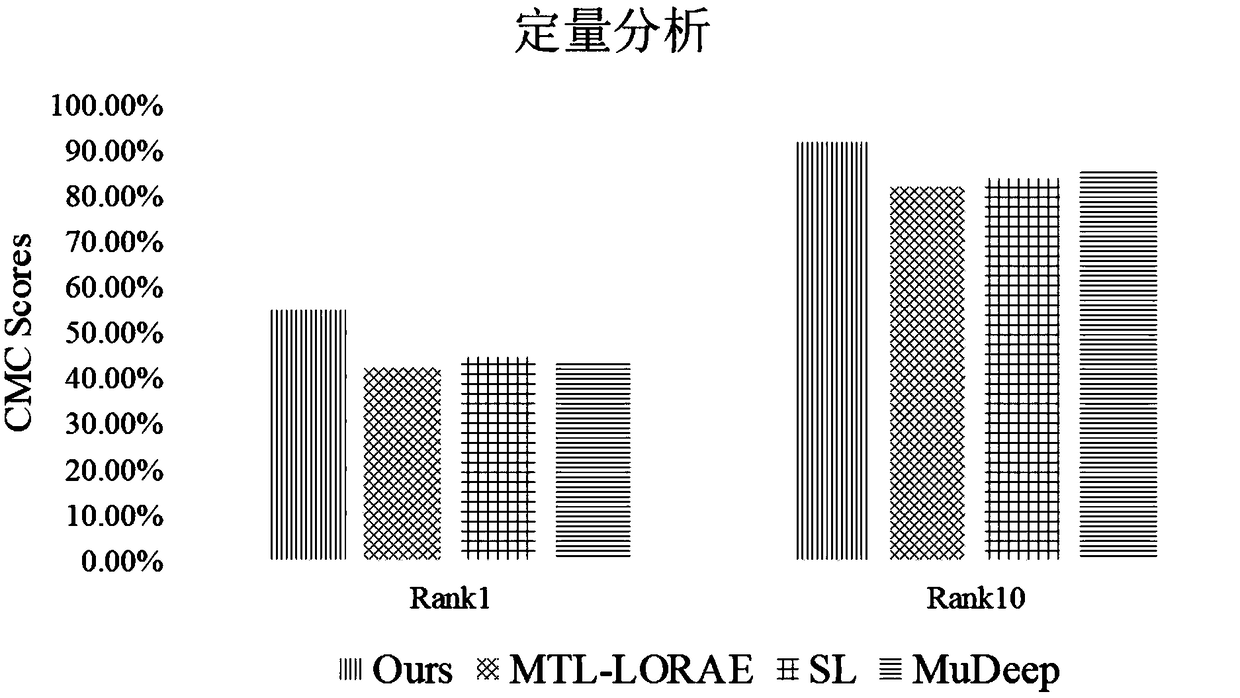A pedestrian re-recognition method based on semantic region expression
A pedestrian re-identification and area technology, applied in the field of image processing and computer vision, can solve the problems of pedestrian misalignment, not considering two images, not considering interference factors, etc., to avoid interference, improve robustness and reliability, Improve indexability
- Summary
- Abstract
- Description
- Claims
- Application Information
AI Technical Summary
Problems solved by technology
Method used
Image
Examples
Embodiment 1
[0030] The embodiment of the present invention proposes a pedestrian re-identification method based on semantic region expression, see figure 1 , the method includes the following steps:
[0031] 101: According to the high-level semantic information of pedestrians, extract the features of different body parts in the foreground of the image, and combine the global features and local features of the image to obtain a more complete feature description of pedestrians;
[0032] 102: Use the triplet loss to train the metric function, so that the distance between the features of the same pedestrian in the new mapping space is as small as possible, and the distance between the features of different new people is as large as possible.
[0033] This method mainly includes five parts: semantic region extraction, image feature extraction within the semantic region, image global and local region feature extraction, calculation of similarity between image samples, and training of metric lea...
Embodiment 2
[0036] The scheme in embodiment 1 is further introduced below in conjunction with specific calculation formulas and examples, see the following description for details:
[0037] 1. Image Feature Extraction in Semantic Regions
[0038] The pedestrian re-identification algorithm first uses the pedestrian detection algorithm to detect the pedestrians in the surveillance video, and then finds the correct matching target according to the similarity between the images. Since the rectangular frame obtained by the pedestrian detection algorithm contains certain background information in addition to the pedestrian, if the global feature of the image is used for matching, this feature will contain a lot of background information interference, which will bring a greater impact on the matching accuracy. influences.
[0039] In addition, due to factors such as viewing angle and pedestrian pose transformation, the positions of pedestrians between images are not aligned. It is possible that...
Embodiment 3
[0074] Combine below figure 1 The scheme in embodiment 1 and 2 is carried out feasibility verification, see the following description for details:
[0075] figure 2 The test results of this method on the general pedestrian re-identification dataset VIPeR are given. The vertical axis is the CMC cumulative matching score, and the horizontal axis is the ranking. Among them, Rank1 represents the probability that the correctly matched target ranks first, and Rank10 represents the probability that the correctly matched target ranks in the top ten. from figure 2 As can be seen in , by utilizing the semantic component information of pedestrians, this method achieves the best results on different evaluation metrics.
[0076] On Rank1, the current best performance results under this data set have been achieved, and on Rank10, an accuracy of more than 90% has been achieved, indicating that the vast majority of correctly matched samples will appear in the top ten of the retrieval res...
PUM
 Login to View More
Login to View More Abstract
Description
Claims
Application Information
 Login to View More
Login to View More - R&D
- Intellectual Property
- Life Sciences
- Materials
- Tech Scout
- Unparalleled Data Quality
- Higher Quality Content
- 60% Fewer Hallucinations
Browse by: Latest US Patents, China's latest patents, Technical Efficacy Thesaurus, Application Domain, Technology Topic, Popular Technical Reports.
© 2025 PatSnap. All rights reserved.Legal|Privacy policy|Modern Slavery Act Transparency Statement|Sitemap|About US| Contact US: help@patsnap.com



